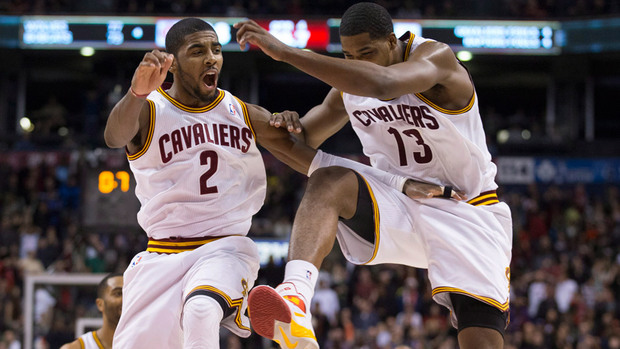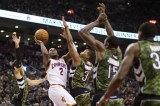Twenty-nine games in the books and ten wins to show for it, not exactly as horrid as ESPN’s prediction of dead last, and not great with a 12th place conference ranking. The caveat in either case is that 4 games separate the 8th seed from the last place team in the conference, and the Raptors are within 2 games of 8 other teams. It’s like the tail end of a train wreck.
Player evaluations at this point:
Andrea Bargnani (34.7 mpg, 21.2 pts, 5.6 reb, 1.7 asts): His most complete season so far, especially when compared to his last two. Chris Bosh’s exit has meant more equitable ball distribution albeit slightly skewed towards Bargnani. The former #1 pick has seized the opportunity and is hoisting 3 more shots a game and has also improved his shot-selection and aggressiveness. His FTA/FGA rate has improved by 8% to 28%, and he’s taking 0.8 less threes a game, which account for only 19% of his shots (compared to 29% last year). Was Bosh’s presence in the paint a deterrent to drive? Possibly, the more likely explanation for this shift in offense is that his role has expanded from a three-point shooter assigned to spread the floor, to a player you go through to create your overall offense. Defensively, he’s still bad and there’s no denying that. Great defensive performances are rare (New Jersey) and something nobody’s quite expecting, but his help defense and lack of ability to discourage would-be drivers continues to be a problem. Despite the many good things he does on offense, his on-off numbers remain shocking: a whopping -16.7 swing per 100 possessions. His TS% has finally returned to what it was his rookie year and he’s got a decent eFG%, so it’s hard to point to his offense being inefficient or in any way detrimental to the team, which leaves his defense as the sole suspect in this ongoing saga. B
Leandro Barbosa (24 mpg, 12.9 ppg, 2.0 apg, .83 spg, 45% FG): With the exception of a few games where his shot has been off, perhaps due to being hampered by injuries, Barbosa has been as advertised. His defense was seen as a cause for concern in the summer, however, that turned out to be a massive exaggeration. He’s been the proverbial spark off the bench and has even been a player who the Raptors have ridden in quite a few games. His effort level doesn’t seem to dip, his active hands and deny positions always seem to cause trouble on inbound passes, and he’s second on the team in steals (Calderon, Weems). When asked to play the true point, Barbosa has fared well showing elements of patience and playmaking that nobody quite expected of him. The question remains that in a rebuilding year, is it wiser to hang on to Barbosa (28 years old) and ride his energy, or do you parlay him into an asset that will be around for when this team hopefully starts contending (2-3 years). Either way, you can’t really go wrong. B+
DeMar DeRozan (31.7 mpg, 12.7 ppg, 3.3 rpg, 45% FG): The word on the street is that DeRozan’s having a poor season and if statistics alone are to be considered, that’s simply not true. His PER36 numbers are almost identical to last year. And therein lies the problem. Maintaining status quo with the 10 extra minutes he’s been awarded this year has to be considered a disappointment, and even if one discards his stagnant statistical figures, it’s his lack of development in key areas that is more concerning. Still plagued by an incongruous jumper and a very limited set of offensive moves, DeRozan’s expected scoring growth and overall impact on the offensive end has been restricted. His lone friend remains the FT line which he usually gets to via a spin move or some other foray into the paint which presents little in the way of a shot opportunity for one of his teammates. His performance on the defensive side of the ball has compounded the negative opinions, a distinct lack of awareness and fundamentals has seen him often become a liability in a position where you simply cannot afford to have a turnstile play 31 minutes a night. We’re still waiting for him to show something that says he’s more than a run-of-the-mill NBA shooting guard. The jury’s still out on that but at least he has time on his side. With only two combined years of NCAA and NBA experience under his belt, DeRozan has a some ways to go before being written off. To be more specific, he also has next year. C
Sonny Weems (27.2 mpg, 11.5 ppg, 3.0 rpg, 0.92 spg): I suppose the warnings signs about his commitment to the cause were there when after the disappointing 104-88 loss to the Bulls last April, Weems started singing. This wasn’t just some plain old loss in January to the Pistons on the road. This was a home defeat to the Bulls which sealed our lottery fate. Then, earlier this year he says:
“I’m trying to be a little calm this year but you have to keep it fun on the court, you can’t be serious all the time,” said Weems. “Even if we’re losing games, you can’t be serious all the time. You can’t have everyone coming in the dressing room frowning, you’ve got to have somebody to lighten it up and that’s what I try to do.”
Much like DeRozan, the expectations for Weems were high given his showing the previous season. A strong jumper, excellent in transition, great athleticism, guaranteed playing time and a contract year appeared to be the perfect ingredients for a year that might earn him a big cheque. Unfortunately, his motor is defective and he zones in and out of possessions – both offensive and defensive. I can even understand taking a defensive possession off, but this guy even appears lazy when he has the ball in his hands, that’s got to be a first! Check the PER36 comparison with DeRozan and there’s not much to pick from, except that he’s three years older and should be a helluva lot more motivated to carve his spot on next year’s roster. So far, though, it’s all been selfish offense and bad defense. C-
Linas Kleiza (24.7 mpg, 11.2 ppg, 4.6 rpg): The post from a couple days ago talked about his numbers on and off the bench and alluded to his slow start to the season being possibly caused by injury. Perhaps trying to justify his contract or maybe simply over-confident from his success in Turkey, Kleiza tried to do too much in the first quarter of the season by venturing into unknown territory. Dribble-drives with a guard swiping at the ball isn’t his thing, nor is anything more than three dribbles on a post-up, you can just forget about a re-post. Now that he’s had a chance to reflect from the bench, he’s returned to the lineup with a surety about his game that’s been missing all season. You’re not seeing many of those unheralded moves that could only work in an international game, he’s doing what he does well: mixing it up with catch-and-shoots, rebounding, straight-line drives and using his bulk at the three in his favor. He poses a slight problem because he’s only shooting 32% three (2 points below his career average), and that’s an area we hoped that he might improve in, especially given the 25th place accuracy ranking for the Raptors. Defensively, he’s been poor in help situations and as an individual defender, nothing that should come as a surprise. Have to say that overall Kleiza’s been pretty much what a reasonable man would have expected. B-
Reggie Evans (27.3 mpg, 4.0 ppg, 12.1rpg): Raptors were 6-9 before he got hurt and 4-10 since. It’s not a massive difference, but a difference nonetheless. Evans needs to be credited for injecting a sense of enthusiasm and work-ethic into the team as it got out of the gates. The impact his performances have had on the team cannot be discounted and he deserves full credit for the improved overall effort coming from the Raptors this year. Since his injury, the Raptors haven’t exactly lost too many games for lack of rebounding, their average differential since his injury is -0.4. You get a feel that his presence on the bench alone lights a spark on the team. And that whole “rebound thief” theory? Well, he is collecting 35.1% of all defensive rebounds, that shatters any of his previous marks, but he’s getting them because they’re there to get and he’s the first one at it. That’s how rebounding works. A-
Part II has Calderon, Johnson, Bayless, Davis, Wright and Dorsey.




